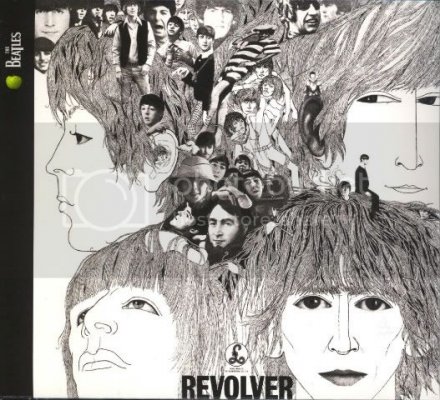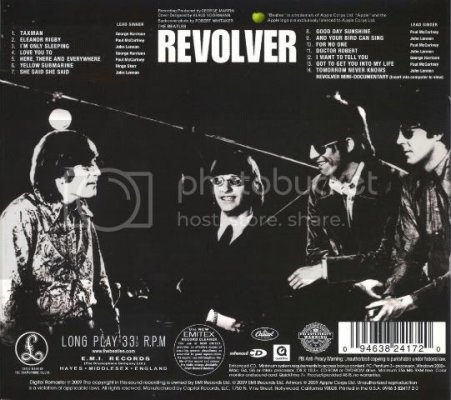Craig in Indy
Your cool Uncle
Revolver (1966)


This was the album, IMO, on which the Beatles broke the mold. Or maybe it’s more accurate to say they broke it with Rubber Soul since that one was the last of its kind – a collection of love songs, basically. Here they get 4 songs into the album without a single love song among them, and by the time the record’s 14 tracks have come and gone, there’ve only been 2 or 3 total (depending on what you consider to be a love song). And the change in lyrical focus goes hand in hand with more sophisticated song structures, recording techniques and instrumentation. What all this meant for me personally is that it was the first Beatle album where I had to actually work to like some of the songs. And there are still some I don’t particularly care for, but I understand them, and understand how ground-breaking they were. This was a pivotal album, and one that paved the way artistically for Sgt. Pepper, which couldn’t have even existed without this record having been made first. You have to give them credit as artists – this album could have well alienated a substantial part of their fan base, or would have if those fans hadn’t been so rabid to begin with.
1 – “Taxman”
I’m hearing the same changes that were evident throughout Rubber Soul, i.e., extended (and better-defined) bass, extended highs that help bring additional texture to drums, percussion and vocals, what seems to be a greater dynamic range and a bit of a boost in levels in general.
2 – “Eleanor Rigby”
I’ve been looking forward to this remaster ever since the Love CD came out. There were snippets of the string quartet from this song that the producers isolated on that album, and I was astonished at the quality of that recording. I’m hearing the same improvements here. The additional definition in the lower mids and upper bass really highlight the cello, giving it body and weight that it lacked before, and adding some texture at the edges of the sound that makes it much more real, as though you can hear the rosined bow digging into the strings at the start of each stroke. The only down side to this is the cello can get a little lost in the increased bass response of the rest of the instruments. It doesn’t stand out as much.
3 – “I’m Only Sleeping”
Bass response is the big beneficiary here, though there are improvements to the guitar and drums, the latter now sounding like they’re in the same room as the vocals, when before they might as well have been down the hall.
4 – “Love You To”
Again, greater dynamic range, better highs and lows, and some increased depth of sound stage.
5 – “Here, There and Everywhere”
The guitar chords that open in the right channel ring much more clearly, and the drum (floor tom?) that leads into the opening verse has a nice weight to it that wasn’t there before. Otherwise, the same general improvements noted before are present here.
6 – “Yellow Submarine”
Much nicer textural “edges” to Ringo’s vocal, and the transient attacks of the left-channel guitar strum are much clearer than before.
7 – “She Said She Said”
Very nice bass on this. In fact, that clearer bass, and all the other improvements in the sound of this song are causing me to hear for the first time similarities in structure and instrumentation between this piece and “Rain.” Since the latter wasn’t issued on any LP at the time, I don’t know off the top of my head if it’s a contemporary of this recording or not. Funny what pops into your head.
8 – “Good Day Sunshine”
A little more definition in the piano here. The other changes mentioned before are evident but they don’t seem quite as dramatic for some reason. The changes here are subtle.
9 – “And Your Bird Can Sing”
Other than a general boost in level, this one doesn’t seem much different to my ears. While the guitar is playing, it’s one of the more aurally dense recordings they’d made up to this point, and while it doesn’t sound bad, it still hits you as kind of a wall of sound.
10 – “For No One”
Paul’s vocal stands out from the backing tracks a little more clearly, and as on other songs, it seems to have a little additional texture.
11 – “Doctor Robert”
Same changes as on others – greater extension at the frequency extremes, and better dynamic range.
12 – “I Want to Tell You”
The original CD version of this song was pretty disappointing, particularly in the drums. They had managed to sound not only distant, but also nasal, which is a real accomplishment for a drum recording. The remaster is better, but still far from perfect. The nasality has been reduced, but it still sounds like Ringo was playing in the next room. However, I did hear a piano in the introduction that I had not noticed before.
13 – “Got to Get You Into My Life”
Again, better dynamics, and the vocal stands out from the backing tracks a bit better. The horns are more prominent, but may suffer just a bit from a little harshness.
14 – “Tomorrow Never Knows”
This one is another pretty dense aural landscape, and it benefits from the greater frequency extension and improvements in dynamic range better than “And Your Bird Can Sing.” It’s easier to hear “into” the song here, which is a really good thing on this composition. There’s a lot going on here.


This was the album, IMO, on which the Beatles broke the mold. Or maybe it’s more accurate to say they broke it with Rubber Soul since that one was the last of its kind – a collection of love songs, basically. Here they get 4 songs into the album without a single love song among them, and by the time the record’s 14 tracks have come and gone, there’ve only been 2 or 3 total (depending on what you consider to be a love song). And the change in lyrical focus goes hand in hand with more sophisticated song structures, recording techniques and instrumentation. What all this meant for me personally is that it was the first Beatle album where I had to actually work to like some of the songs. And there are still some I don’t particularly care for, but I understand them, and understand how ground-breaking they were. This was a pivotal album, and one that paved the way artistically for Sgt. Pepper, which couldn’t have even existed without this record having been made first. You have to give them credit as artists – this album could have well alienated a substantial part of their fan base, or would have if those fans hadn’t been so rabid to begin with.
1 – “Taxman”
I’m hearing the same changes that were evident throughout Rubber Soul, i.e., extended (and better-defined) bass, extended highs that help bring additional texture to drums, percussion and vocals, what seems to be a greater dynamic range and a bit of a boost in levels in general.
2 – “Eleanor Rigby”
I’ve been looking forward to this remaster ever since the Love CD came out. There were snippets of the string quartet from this song that the producers isolated on that album, and I was astonished at the quality of that recording. I’m hearing the same improvements here. The additional definition in the lower mids and upper bass really highlight the cello, giving it body and weight that it lacked before, and adding some texture at the edges of the sound that makes it much more real, as though you can hear the rosined bow digging into the strings at the start of each stroke. The only down side to this is the cello can get a little lost in the increased bass response of the rest of the instruments. It doesn’t stand out as much.
3 – “I’m Only Sleeping”
Bass response is the big beneficiary here, though there are improvements to the guitar and drums, the latter now sounding like they’re in the same room as the vocals, when before they might as well have been down the hall.
4 – “Love You To”
Again, greater dynamic range, better highs and lows, and some increased depth of sound stage.
5 – “Here, There and Everywhere”
The guitar chords that open in the right channel ring much more clearly, and the drum (floor tom?) that leads into the opening verse has a nice weight to it that wasn’t there before. Otherwise, the same general improvements noted before are present here.
6 – “Yellow Submarine”
Much nicer textural “edges” to Ringo’s vocal, and the transient attacks of the left-channel guitar strum are much clearer than before.
7 – “She Said She Said”
Very nice bass on this. In fact, that clearer bass, and all the other improvements in the sound of this song are causing me to hear for the first time similarities in structure and instrumentation between this piece and “Rain.” Since the latter wasn’t issued on any LP at the time, I don’t know off the top of my head if it’s a contemporary of this recording or not. Funny what pops into your head.
8 – “Good Day Sunshine”
A little more definition in the piano here. The other changes mentioned before are evident but they don’t seem quite as dramatic for some reason. The changes here are subtle.
9 – “And Your Bird Can Sing”
Other than a general boost in level, this one doesn’t seem much different to my ears. While the guitar is playing, it’s one of the more aurally dense recordings they’d made up to this point, and while it doesn’t sound bad, it still hits you as kind of a wall of sound.
10 – “For No One”
Paul’s vocal stands out from the backing tracks a little more clearly, and as on other songs, it seems to have a little additional texture.
11 – “Doctor Robert”
Same changes as on others – greater extension at the frequency extremes, and better dynamic range.
12 – “I Want to Tell You”
The original CD version of this song was pretty disappointing, particularly in the drums. They had managed to sound not only distant, but also nasal, which is a real accomplishment for a drum recording. The remaster is better, but still far from perfect. The nasality has been reduced, but it still sounds like Ringo was playing in the next room. However, I did hear a piano in the introduction that I had not noticed before.
13 – “Got to Get You Into My Life”
Again, better dynamics, and the vocal stands out from the backing tracks a bit better. The horns are more prominent, but may suffer just a bit from a little harshness.
14 – “Tomorrow Never Knows”
This one is another pretty dense aural landscape, and it benefits from the greater frequency extension and improvements in dynamic range better than “And Your Bird Can Sing.” It’s easier to hear “into” the song here, which is a really good thing on this composition. There’s a lot going on here.

